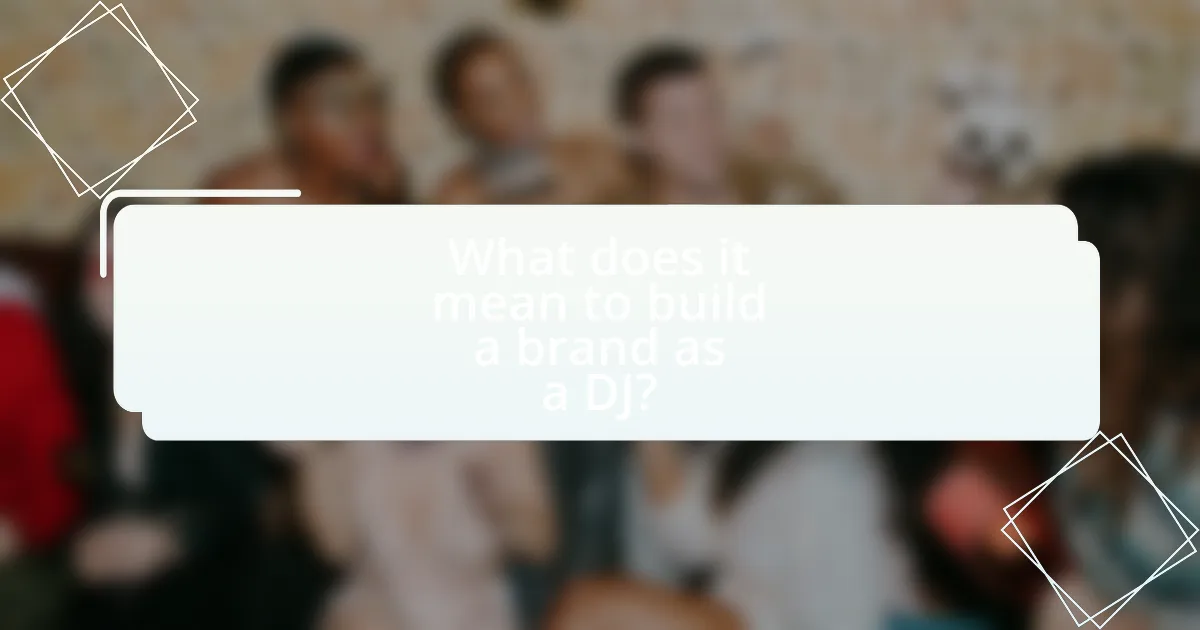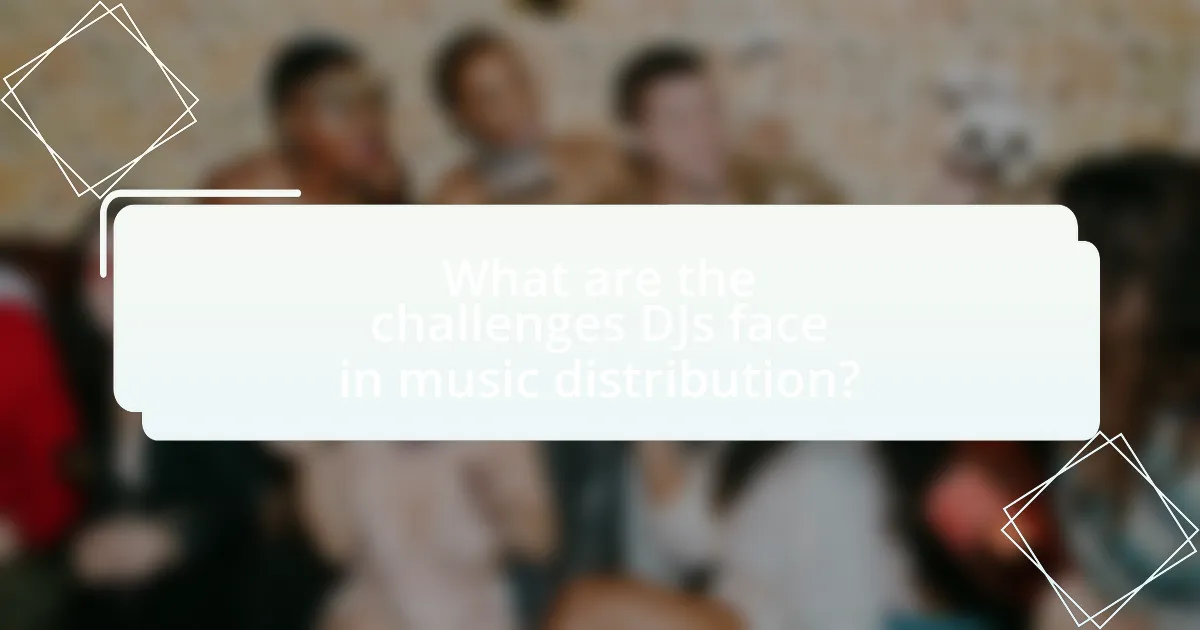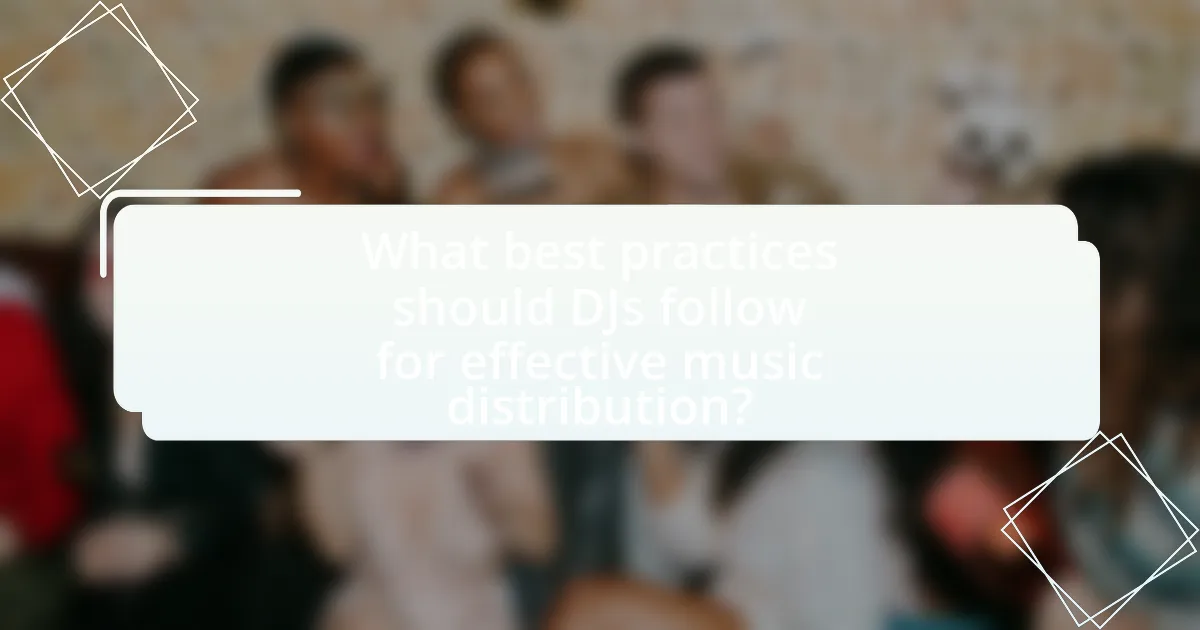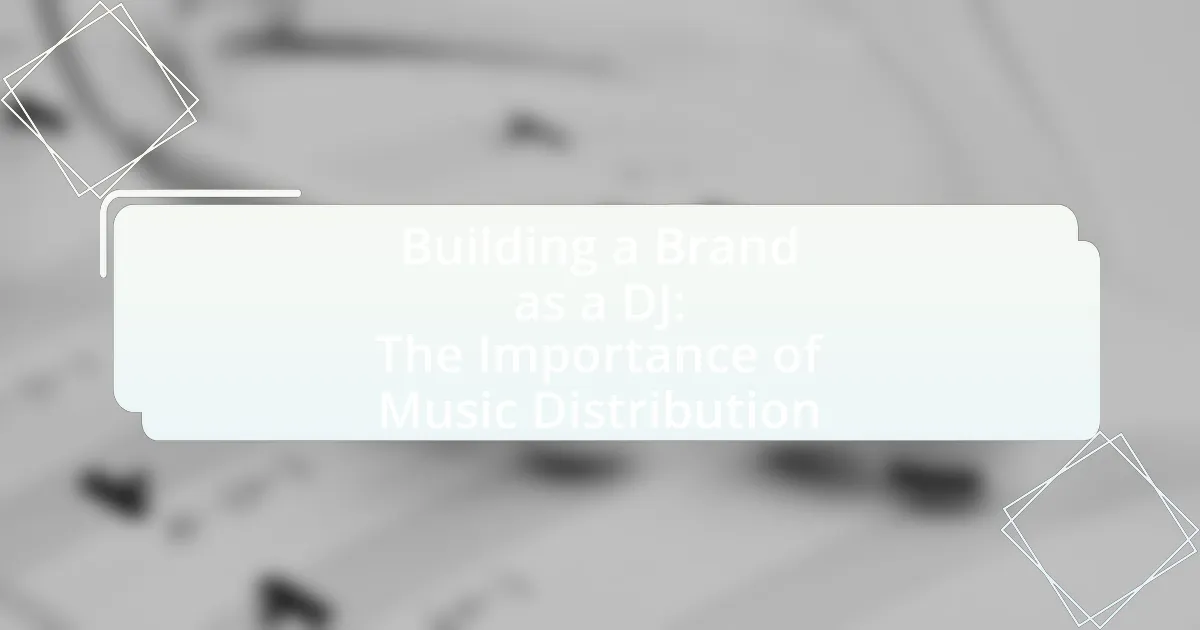Building a brand as a DJ involves creating a unique identity that distinguishes the DJ in a competitive market, encompassing elements such as musical style, visual identity, and audience engagement. Effective branding is crucial for establishing recognition and loyalty, which can lead to increased booking opportunities and fan connections. Music distribution plays a vital role in enhancing a DJ’s visibility and marketability, with various channels available, including streaming services and social media. DJs face challenges such as copyright issues and platform saturation, but by leveraging targeted marketing and collaborations, they can optimize their distribution strategies and strengthen their brand presence in the music industry.

What does it mean to build a brand as a DJ?
Building a brand as a DJ means creating a distinct identity that resonates with audiences and differentiates the DJ in a competitive market. This involves developing a unique style, consistent visual elements, and a recognizable name that reflects the DJ’s musical genre and persona. For instance, successful DJs like Calvin Harris and Tiësto have established strong brands through signature sounds, engaging social media presence, and memorable performances, which contribute to their marketability and fan loyalty.
Why is branding important for DJs?
Branding is important for DJs because it establishes their identity and differentiates them in a competitive market. A strong brand helps DJs connect with their audience, build a loyal fan base, and create memorable experiences. For instance, a well-defined brand can lead to increased recognition, which is crucial in an industry where numerous artists compete for attention. According to a study by the International Music Summit, effective branding can significantly enhance a DJ’s marketability and opportunities for bookings, as it influences how promoters and fans perceive their value.
How does a strong brand identity impact a DJ’s career?
A strong brand identity significantly enhances a DJ’s career by establishing recognition and loyalty among audiences. This recognition allows DJs to differentiate themselves in a competitive market, leading to increased booking opportunities and higher demand for their performances. For instance, a study by the International Music Summit in 2020 indicated that DJs with a well-defined brand identity experienced a 30% increase in gig requests compared to those without. Furthermore, a strong brand identity fosters a deeper emotional connection with fans, which can translate into a dedicated following and increased merchandise sales. Thus, a robust brand identity is crucial for a DJ’s success and longevity in the industry.
What elements contribute to a DJ’s brand image?
A DJ’s brand image is primarily shaped by their musical style, visual identity, social media presence, and audience engagement. The musical style defines the genre and sound that the DJ is associated with, influencing their target audience and marketability. Visual identity, including logos, merchandise, and stage presence, creates a recognizable aesthetic that fans can connect with. Social media presence is crucial for building a community and promoting events, as platforms like Instagram and Twitter allow DJs to interact directly with their audience. Audience engagement, through live performances and fan interactions, solidifies the DJ’s reputation and fosters loyalty. These elements collectively contribute to a cohesive brand image that resonates with fans and distinguishes the DJ in a competitive industry.
What role does music distribution play in branding?
Music distribution plays a crucial role in branding by ensuring that an artist’s music reaches a wide audience, thereby enhancing visibility and recognition. Effective distribution channels, such as streaming platforms and digital retailers, allow DJs to establish their presence in the market, which is essential for brand development. For instance, according to a report by the International Federation of the Phonographic Industry (IFPI), over 70% of music consumption now occurs through streaming services, highlighting the importance of these platforms in shaping an artist’s brand identity. By leveraging music distribution, DJs can not only share their unique sound but also connect with fans, create a loyal following, and differentiate themselves in a competitive industry.
How does effective music distribution enhance a DJ’s visibility?
Effective music distribution enhances a DJ’s visibility by ensuring their tracks reach a wider audience across various platforms. When a DJ’s music is distributed effectively, it becomes accessible on streaming services, digital download sites, and social media, increasing the likelihood of discovery by new listeners. For instance, a study by the International Federation of the Phonographic Industry (IFPI) indicates that 70% of music consumption now occurs through streaming platforms, highlighting the importance of being present on these channels. Additionally, effective distribution often includes promotional strategies that can amplify a DJ’s presence, such as playlist placements and collaborations with influencers, further boosting their visibility in a competitive market.
What are the different music distribution channels available for DJs?
DJs have several music distribution channels available to them, including digital distribution platforms, streaming services, social media, and physical distribution. Digital distribution platforms like DistroKid, TuneCore, and CD Baby allow DJs to upload their music to various online stores and streaming services. Streaming services such as Spotify, Apple Music, and SoundCloud enable DJs to reach a wider audience by making their tracks available for streaming. Social media platforms like Instagram, Facebook, and TikTok provide avenues for DJs to promote their music and engage with fans. Additionally, physical distribution through vinyl or CDs can still be relevant for niche markets and collectors. These channels collectively enhance a DJ’s visibility and brand presence in the music industry.
How can DJs leverage music distribution to build their brand?
DJs can leverage music distribution to build their brand by utilizing digital platforms to reach wider audiences and enhance their visibility. By distributing their music through services like Spotify, Apple Music, and SoundCloud, DJs can gain access to millions of potential listeners, which increases their chances of attracting fans and followers. Furthermore, effective music distribution allows DJs to showcase their unique sound and style, helping to establish a distinct brand identity. According to a report by MIDiA Research, the global music streaming market is projected to grow significantly, indicating that DJs who engage in music distribution can capitalize on this trend to expand their brand presence.
What strategies can DJs use to maximize their reach through distribution?
DJs can maximize their reach through distribution by utilizing multiple digital platforms, engaging in social media marketing, and collaborating with other artists. By distributing music on platforms like Spotify, Apple Music, and SoundCloud, DJs can access a wider audience, as these platforms collectively have millions of users. Social media marketing, particularly on platforms like Instagram and TikTok, allows DJs to promote their music and connect with fans directly, enhancing visibility and engagement. Collaborating with other artists can also expand a DJ’s audience, as it introduces their music to the collaborators’ fan bases, creating cross-promotion opportunities. These strategies are supported by the fact that digital music consumption has increased significantly, with streaming accounting for over 80% of music industry revenue in recent years, highlighting the importance of effective distribution methods.
How does audience engagement through distribution affect brand loyalty?
Audience engagement through distribution significantly enhances brand loyalty by creating a direct connection between the brand and its audience. When DJs distribute their music effectively across various platforms, they increase visibility and accessibility, which fosters a sense of community among listeners. This engagement leads to repeated interactions, reinforcing the audience’s emotional attachment to the brand. Research indicates that brands with higher engagement levels see a 23% increase in customer loyalty, as noted in the “Customer Engagement: A New Frontier for Marketing” report by Gallup. Thus, effective distribution not only amplifies reach but also cultivates lasting loyalty among fans.

What are the challenges DJs face in music distribution?
DJs face several challenges in music distribution, primarily including copyright issues, platform saturation, and revenue generation. Copyright issues arise when DJs use samples or remixes without proper licensing, leading to potential legal disputes and financial penalties. Platform saturation occurs as numerous artists compete for attention on streaming services, making it difficult for individual DJs to stand out and gain traction. Additionally, revenue generation is a significant challenge, as many distribution platforms take a substantial cut of earnings, leaving DJs with limited financial returns despite their efforts. These challenges highlight the complexities DJs must navigate to successfully distribute their music and build their brand.
What common obstacles do DJs encounter when distributing their music?
DJs commonly encounter several obstacles when distributing their music, including copyright issues, limited access to distribution platforms, and competition in a saturated market. Copyright issues arise when DJs use samples or remixes without proper licensing, which can lead to legal challenges and removal of their tracks from platforms. Limited access to distribution platforms can hinder exposure, as not all DJs have the resources or connections to get their music on major streaming services. Additionally, the competition in the music industry is intense, making it difficult for individual DJs to stand out and gain traction among listeners. These challenges can significantly impact a DJ’s ability to effectively distribute their music and build their brand.
How can DJs overcome issues related to copyright and licensing?
DJs can overcome issues related to copyright and licensing by obtaining the necessary licenses for the music they use in their performances. This involves securing performance rights from organizations such as ASCAP, BMI, or SESAC, which manage the rights of songwriters and publishers. Additionally, DJs can utilize royalty-free music or tracks that are licensed under Creative Commons, allowing them to perform without infringing on copyright laws. According to the U.S. Copyright Office, failure to obtain proper licensing can result in legal consequences, including fines and lawsuits, emphasizing the importance of compliance in building a reputable brand as a DJ.
What are the pitfalls of using multiple distribution platforms?
Using multiple distribution platforms can lead to several pitfalls, including inconsistent branding, fragmented audience engagement, and potential revenue loss. Inconsistent branding occurs when a DJ’s image and messaging vary across platforms, confusing fans and diluting brand identity. Fragmented audience engagement arises when listeners are spread across different platforms, making it challenging to build a cohesive community and effectively communicate with fans. Additionally, potential revenue loss can happen due to varying payout structures and fees across platforms, which may result in lower overall earnings. According to a study by the International Music Summit, artists often face difficulties in tracking their earnings and audience metrics when utilizing multiple platforms, further complicating their distribution strategy.
How can DJs ensure their music reaches the right audience?
DJs can ensure their music reaches the right audience by utilizing targeted digital distribution platforms and engaging with their fan base through social media. Digital distribution services like DistroKid or TuneCore allow DJs to distribute their music across multiple streaming platforms, ensuring visibility to specific demographics. Additionally, leveraging social media platforms such as Instagram, TikTok, and Facebook enables DJs to connect directly with their audience, share their music, and receive feedback, which helps refine their approach. According to a 2021 report by the International Federation of the Phonographic Industry, 70% of music discovery occurs through streaming services, highlighting the importance of strategic distribution in reaching the desired audience effectively.
What tools can DJs use to analyze their audience demographics?
DJs can use tools like social media analytics, streaming platform insights, and audience engagement software to analyze their audience demographics. Social media platforms such as Facebook and Instagram provide detailed analytics on follower age, gender, and location, allowing DJs to tailor their marketing strategies. Streaming services like Spotify and SoundCloud offer demographic data on listeners, including age groups and geographic distribution, which helps DJs understand their audience better. Additionally, audience engagement tools like Poll Everywhere or SurveyMonkey enable DJs to gather direct feedback from their fans, further refining their understanding of audience preferences and demographics.
How can targeted marketing improve music distribution outcomes?
Targeted marketing can significantly improve music distribution outcomes by ensuring that promotional efforts reach the most relevant audience segments. By analyzing listener demographics, preferences, and behaviors, targeted marketing allows artists and labels to tailor their messaging and distribution strategies to specific groups, increasing engagement and conversion rates. For instance, a study by Nielsen Music found that targeted advertising can lead to a 30% increase in streaming activity among identified listener segments. This focused approach not only enhances the effectiveness of marketing campaigns but also optimizes resource allocation, leading to higher sales and streaming numbers for artists.

What best practices should DJs follow for effective music distribution?
DJs should follow several best practices for effective music distribution, including utilizing digital platforms, engaging with audiences on social media, and collaborating with other artists. Digital platforms like Spotify, Apple Music, and SoundCloud provide extensive reach and accessibility, allowing DJs to distribute their music globally. Engaging with audiences on social media helps build a loyal fan base and promotes new releases effectively. Collaborating with other artists can enhance visibility and introduce DJs to new audiences, as evidenced by the success of numerous artists who have leveraged partnerships to expand their reach. These practices collectively contribute to a stronger brand presence and increased music distribution effectiveness.
How can DJs create a distribution plan that aligns with their brand?
DJs can create a distribution plan that aligns with their brand by identifying their target audience and selecting distribution channels that resonate with that demographic. This involves analyzing platforms such as Spotify, SoundCloud, and Bandcamp, which cater to specific listener preferences and behaviors. For instance, a DJ focused on electronic music may prioritize platforms known for that genre, ensuring their music reaches the right listeners.
Additionally, DJs should maintain a consistent visual and auditory brand identity across all distribution channels, including cover art, promotional materials, and social media presence. This consistency reinforces brand recognition and loyalty among fans. Research indicates that 70% of consumers prefer brands that are consistent across all platforms, highlighting the importance of a cohesive distribution strategy.
Finally, leveraging data analytics from these platforms can help DJs refine their distribution plan over time, allowing them to adapt to audience feedback and trends, ultimately enhancing their brand alignment.
What key components should be included in a DJ’s distribution strategy?
A DJ’s distribution strategy should include digital distribution platforms, social media promotion, and direct fan engagement. Digital distribution platforms, such as Spotify and Apple Music, are essential for reaching a wide audience and ensuring that music is accessible. Social media promotion allows DJs to connect with fans, share updates, and promote new releases effectively. Direct fan engagement, through email newsletters or exclusive content, fosters a loyal fanbase and encourages repeat listens. These components are critical for maximizing reach and building a brand in the competitive music industry.
How often should DJs update their music distribution efforts?
DJs should update their music distribution efforts at least every month. Regular updates ensure that DJs remain relevant in a fast-paced music industry where trends and listener preferences change frequently. According to a study by the International Music Summit, 70% of successful DJs attribute their brand growth to consistent music releases and updates, highlighting the importance of staying current with new tracks and remixes.
What are the benefits of collaborating with music distribution services?
Collaborating with music distribution services provides artists with increased reach and access to a wider audience. These services facilitate the distribution of music across multiple platforms, such as Spotify, Apple Music, and Amazon Music, ensuring that tracks are available to millions of potential listeners. Additionally, music distribution services often offer marketing tools and analytics, enabling artists to track performance and optimize their promotional strategies. According to a report by MIDiA Research, artists who utilize distribution services can see a significant increase in streams and revenue, highlighting the effectiveness of these collaborations in building a brand and enhancing visibility in the competitive music industry.
How can partnerships enhance a DJ’s brand visibility?
Partnerships can significantly enhance a DJ’s brand visibility by expanding their reach to new audiences and leveraging the credibility of established brands. Collaborating with venues, festivals, or other artists allows DJs to tap into existing fan bases, thereby increasing their exposure. For instance, a DJ partnering with a popular music festival can gain access to thousands of attendees, which can lead to increased social media followers and streaming numbers. Additionally, partnerships often involve cross-promotion, where both parties share content, further amplifying visibility across different platforms. This strategy is supported by the fact that 70% of consumers are more likely to engage with brands that collaborate with others, demonstrating the effectiveness of partnerships in enhancing brand recognition.
What should DJs look for in a distribution partner?
DJs should look for a distribution partner that offers wide reach, reliable support, and transparent terms. A wide reach ensures that the DJ’s music is available on multiple platforms, maximizing exposure and potential sales. Reliable support includes responsive customer service and assistance with marketing strategies, which can enhance the DJ’s brand visibility. Transparent terms involve clear agreements regarding royalties, fees, and distribution rights, allowing DJs to understand their earnings and obligations. According to a 2021 report by the International Federation of the Phonographic Industry, artists who utilize comprehensive distribution services see a 30% increase in audience engagement compared to those who do not.
What practical tips can DJs implement for successful music distribution?
DJs can implement several practical tips for successful music distribution, including utilizing digital distribution platforms, engaging with social media, and building a mailing list. Digital distribution platforms like DistroKid or TuneCore allow DJs to distribute their music across multiple streaming services efficiently, reaching a wider audience. Engaging with social media helps DJs connect with fans and promote new releases, as platforms like Instagram and TikTok have proven effective for music promotion. Additionally, building a mailing list enables DJs to directly communicate with their audience, providing updates on new music and events, which can enhance fan loyalty and increase sales. These strategies are supported by industry trends showing that effective digital marketing and direct fan engagement significantly boost music distribution success.

Leave a Reply